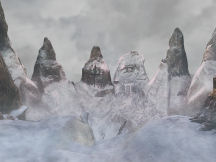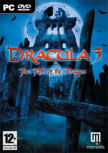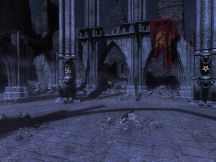Foreword
Bram Stoker’s
Dracula didn’t invent the vampire legend, but it certainly gave it
literary life. Anyone familiar with the book will be aware that the story
is built up by using diary extracts, letters, telegrams, newspaper
articles, medical reports and the like. Various perspectives are also
present, through the journals of Jonathan and Mina Harker, Dr. Seward and
Lucy Westenra.
It’s appropriate,
therefore, that the novel features in The Path of the Dragon, both
literally and figuratively. Not only do you get your own copy (inside the
game world), but by the end of the game you will have sifted a litany of
letters, notes, pamphlets, diaries, photos, drawings and artworks (some of
which I recognised) to complete the many trials that eventually lead to
the end of the aforementioned Path.
It’s not a unique
approach in an adventure game; many inventories contain such things. But
it suits the potpourri of real and imagined events, fact and legend, that
make up the game. I also thought it was a nice homage to the Stoker
tradition. Or perhaps that was me reading too much into it. Whichever --
in keeping with the style, you now get a little homage of my own.
***
Arno Moriani’s
Journal (in Latin) 16 September 1920, Vladivoste Station
The train arrived on time and I have taken a moment to
reflect and to pray. I have been sent to investigate a sainthood, but it
seems unlikely that I will find one here. But the saintly do inhabit the
unlikeliest of places. The destruction I saw from the carriage windows,
and which I can see has touched this place, is perhaps deserving of
something miraculous, but that must not cloud my judgement. I must enter
the town and begin, but it is quiet here at the station, and once begun,
the Promotor Fidei is a heavy mantle. So for just a while longer I will
sit, and simply be a priest.
From
“Monte Saptamanal: 1919” – regional newspaper
The Castle of Twilight
overlooking the town of Vladivoste is the only memorable feature of this
region. The town is charming enough, in its rustic way, but suffered from
the war. It now seems flat and lifeless, an impression that most
travellers through the region will not be able to dispel wherever they go.
The people though retain their optimism and by contrast with their
surroundings seem larger than life, although there are few of them.
Arno Moriani’s
Journal (in Latin) 17 September, Vladivoste Inn
The night terrors
came again. Will I ever be rid of them? The boundary between heaven and
hell seems fleeting at times like these. At least this time I was not
suffocating, but who was that woman?
My day yesterday was
a gentle one, almost peaceful, but I expect things will become more
difficult. I must be about my tasks at once!
Notes – Stephan Luca
(in shorthand)
Met with Father A. He
remains sceptical. Gave him the documents. Will he help me? Will try again
– a priest would be a powerful ally.
Medical Notes – Dr.
Martha Calugarul
Patient exhibited
anaemia. Transfusion gives only temporary improvement. P anomaly present
in blood. Haematoma and bruising on neck.
Dissertations sur
les Apparitions des Anges, des Demons et des Esprits, et sur les Revenants
et Vampires - Dom Augustin Calmet, 1746
The name given to these
ghosts is Oupires, or Vampires, that is to say blood-suckers, and the
particulars which are related of them are so singular, so detailed,
accompanied with circumstances so probable and so likely, as well as with
the most weighty and well-attested legal deposition that it seems
impossible not to subscribe to the belief which prevails in those
countries that these Apparitions do actually come forth from their graves
and that they are able to produce the terrible effects which are so widely
and so positively attributed to them.
“Tower of Babel”
Pieter Brueghel (Elder) c: 1563
Oil on panel 114 × 155
cm Kunsthistorisches Museum, Vienna
Arno Moriani’s
Journal (in Latin) 17 September, train from Budapest
To think I set out
to find a saint, but now seek to reaffirm what Pope Benedict denounced
almost 200 years ago after the Calmet dissertation. That people still
speak of vampires in this enlightened time surprises me.
As I suspected, my
takes become more difficult. My training as a medic enabled me to complete
the blood tests yesterday, but my skills were rusty. Trial and error
eventually triggered the knowledge – thank goodness it was only my own
arm! And thank goodness my mind remains sharp.
It will need to be.
The documents and information I carry become more voluminous by the day,
and my research will reveal many more. Keeping them organised is a task,
but my system of cataloguing makes it manageable. I will need to spend
time tagging those that are useful and discarding those that are useless,
but I must exercise care. Much which seems unimportant may eventually be
the key.
I will review my
notes of my conversations while I travel. Though lengthy, they may help me
interpret what Prof. Irina just told me. Thule, the Lords of Twilight,
hidden messages in sacred art – and the Path of the Dragon and Vlad Tepes.
If only I could organise my notes like my documents!
I will make a list
too of my next steps. I must talk again with Janos and Stephan, and check
my mail. This lists keeps me focused amidst the confusion.
And I must pray.
Description of Vlad
Tepes by Nicolas of Modrussa,
papal
legate to Pope Pius II (1458-64)
He was not very tall,
but very stocky and strong, with a cruel and terrible appearance, a long
straight nose, distended nostrils, a thin and reddish face in which the
large wide-open green eyes were enframed by bushy black eyebrows, which
made them appear threatening. His face and chin were shaven but for a
moustache. The swollen temples increased the bulk of his head. A bull's
neck supported the head, from which black curly locks were falling to his
wide-shouldered person.
From “The Lords of
Twilight or Fulfilment of the Race” - excerpt (date unknown)
The Path of the Dragon
is an initiatory journey which offers to the human being who undertakes it
the chance to transcend his condition in order to join the lords. Marked
by trials along the way…it offers immortality and the power to live beyond
the grace of god.
Arno Moriani’s
Journal (in Latin) 18 September, Vladivoste Inn
There is no longer
any doubt. I must follow the Path of the Dragon until the end and destroy
the evil that I will find there.
“The vampiric
epistolary” – excerpt from thesis (undated and unattributed)
The Kostova novel is
not a true example of the epistolic form, but through the infusion of
letters and notes perhaps we see an example of the genesis of the form. It
also uses excerpts from different time periods, requiring the reader to
look simultaneously and reflectively at events as the narrative develops.
Stoker’s Dracula
is a more conventional example, but its use in other forms is not always
as conventional. For example, when Maria gives Father Arno a copy in
Path of the Dragon, a computer game from a few years ago, not only
does it shed light on the legend, it illuminates (were it necessary) the
extent to which Arno must look within his own collection of documents and
writings to discover what he seeks.
“St. Sebastian” -
Andrea Mantegna: 1480
Oil on Canvas, 255 x
140 cm Musee de Louvre, Paris. Originally part of the Altar of San Zeno,
Verona
Arno Moriani’s
Journal (in Latin) 18 September, train from Urguyurt
I now know the first
trial of the Path, but have yet to find the place to begin. I am becoming
impatient; why must there always be obstacles in the way? Yet I am sure
that I am slowly gaining the knowledge I need, so I must be patient.
There is foreboding
all around me now. It is so palpable, I can almost hear it; a musical
accompaniment plucking the very mood from the walls and the sky. I must
not let my imagination get the better of me; my wits are what I need, not
fancy.
I have a confession.
I have ceased turning to the bible for inspiration. It keeps trying to
speak to me from within my cache of documents, but I can no longer
understand its voice. Perhaps I am changing.
I almost fear the
things I must do. If I perish, will I be reborn? I believe that I will.
Someone wants me to succeed. But is it my God, or someone else? I don’t
know anymore.
Arno Moriani’s
Journal (in Latin) 19 September, the 7 pillars (location unknown)
I sit before the 7
pillars, the last of the trials on the Path. I feel the need to pause, as
I did before this all started.
I think about what I
have done. It was hard, and more than once I feared I would fail. Yet it
excited me, and it challenged me, and it kept me going.
Was I frightened?
Not by the events, but I have indeed changed, and that frightens me. If I
have understood what has happened, I will soon stand before the Master,
and be judged. That too frightens me. Will I have the strength to do what
I know I must?
His Path was almost
too long, too much after what had come before, and relentless, but I made
it. I have an idea of what I must do to complete the final trial, but I
have much need to think. The pieces are all with me, but it will take some
time to sift them from their mundane surroundings and put them together
correctly.
I will pray, and
then I will get started.
From “Monte
Saptamanal: 1933” – regional newspaper
The discovery of a
manuscript has recently shed some light on mysterious events which
occurred in our local region just after the end of the war. The so-called
MaGtRo Walkthrough describes in great detail what at times seem the almost
impossible solutions to a series of conundrums faced by one Father Arno.
Father Arno was connected to the disappearance of a local doctor, although
nothing more is known.
Whatever the father
might have been involved in, the new manuscript makes it clear he must
have been a clever man. He faced many challenges, and from the smallest
clues was seemingly able to move forward. Whilst it seems his challenges
arrived one at a time, the necessary bits and pieces to their solution
would have escaped the notice of many. Some are diabolically clever,
seemingly random until examined anew. Only the final judgement appears to
escape logical resolution; whether Father Arno found that disappointing
will never be known.
***
Afterword
Whatever Father Arno
felt, I thought the final puzzle was a big letdown. In fact, I had to
pause a few days and reflect before finalising this review.
The final taste in your
mouth is important, especially if, as here, you are setting things up for
a sequel. Indeed, maybe the little cutscene at the end was intended to be
a digital mouthwash.
Path of the Dragon
does the good things really well, does most things to a perfectly
acceptable standard, and does some things less than it could. The puzzles,
and there are lots of them, the inventory management and the music are all
in the first category. So too the animation of the characters, many with
their own little mannerisms (watch the good doctor fiddle with her hair),
and the attention to ambient detail (the rising heart beat, the
breathlessness when climbing a hill).
The plot I put in the
second category, especially the subplot, along with the visual world (it’s
a little flat) and the voice acting generally, although some voices are a
notch higher. Father Arno though didn’t convince me. It needed better
puzzle balance too; too many at the back, too few at the front. I accept
that the path itself was always going to be a succession of trials, but
the rest could have been evened out more. By comparison with the last
third, the start is almost pedestrian. Not every puzzle or conundrum is
totally logical either (a couple in particular are mostly trial and error)
but they don’t need to be.
Some more characters
would have been good, especially more Vlad. If I play something called
Dracula, I want Dracula. The vampire-ness in this game lurked in the
shadows, but never quite showed enough of itself.
The last category? The
final puzzle and the dialogue management, both by comparison. Most of the
puzzles are hard but subtly crafted, and inventory management is awesome –
so the failings in these things shine.
So looking back, I was
a little disappointed. But reflecting on other games I have played
recently, and on what we look for in adventure games, it really was quite
good.
-
Challenging mix of logical puzzles and situation conundrums
-
Somewhat unbalanced, the last
third becoming a
little overwhelming puzzle-wise
-
Steady start lets you settle in
-
Superb inventory management system
-
Intriguing mix of real and fictional events and persons
-
Storyline a little messy, and the subplot seems too
contrived
-
Disappointing final puzzle, unworthy of what went before
-
Stunning sound track
-
Can die, but will be automatically “reborn” just prior to
the fatal event
-
Fairly large information dump of who did what prior to the
end
-
Character animation excellent, great cutscenes and
generally good voice acting
-
All dialogue reviewable, but builds to about 200 pages that
can only be gone through one page at a time
-
Detailed game world, if a little flat
-
Point and click first person perspective
-
Cursor
fixed in centre of screen, and scene pans 360 degrees around it as you
move the mouse
-
Game loads quickly and no glitches or bugs experienced
B
August 2008
design copyright ©
2008
GameBoomers
Group





